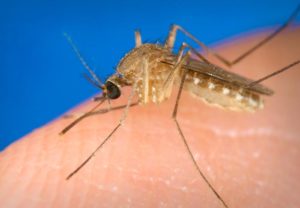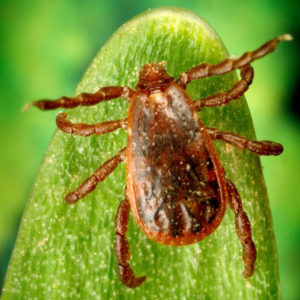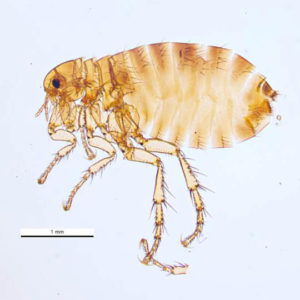Vectors
A vector is any animal or insect that is capable of transmitting pathogens to people or harming them. Common vectors around the world are rodents, mosquitoes, ticks, and fleas. In our District, mosquitoes are the primary vectors of public health concern.
Click to jump to section.
Mosquitoes
Roughly 50 mosquitoes species can be found in California. Only 15 of these mosquito species are considered to be of public health importance in Tulare County because of their nuisance biting or their potential to transmit pathogens through their bites. By understanding the general mosquito life cycle, we can reduce the overall mosquito population and bites.
Life Cycle
Mosquitoes have four life stages: egg, larva, pupa, and adult. All but the final, adult life stage takes place in water. By reducing or eliminating standing water, we can stop mosquito bites before they start. No standing water means no mosquitoes!
Eggs are the first stage of the mosquito life cycle. A single female mosquito lays about 100-300 eggs at a time. Anopheles mosquitoes lay single eggs at a time while Culex and Culiseta mosquitoes lay eggs in the form of rafts on top of standing water. Aedes mosquitoes lay their eggs along the waterline of containers, treeholes, and other water sources. Most eggs will hatch into larvae within 24 to 48 hours.

Eggs are the first stage of the mosquito life cycle. A single female mosquito lays about 100-300 eggs at a time. Anopheles mosquitoes lay single eggs (right) at a time while Culex and Culiseta mosquitoes lay eggs in the form of rafts on top of standing water (left). Aedes mosquitoes lay their eggs along the waterline of containers, treeholes, and other water sources (middle). Most eggs will hatch into larvae within 24 to 48 hours.
 Larvae live in the water but breathe air at the water’s surface. They feed on microorganisms and organic matter in the water. When they sense movement or are disturbed, larvae dive to the bottom of their water sources for safety. Larvae shed their exoskeleton four times, in a process called molting, to grow. The stages between molts are called instars. After the fourth molt, the larva becomes a pupa.
Larvae live in the water but breathe air at the water’s surface. They feed on microorganisms and organic matter in the water. When they sense movement or are disturbed, larvae dive to the bottom of their water sources for safety. Larvae shed their exoskeleton four times, in a process called molting, to grow. The stages between molts are called instars. After the fourth molt, the larva becomes a pupa.
Photo Credit: James Gathany, 2003, CDC
 Pupae are the final developmental stage before a mosquito becomes an adult. Like larvae, pupae need to breathe air at the water’s surface and dive to the bottom to avoid predators. Unlike larvae, pupae do not eat. Instead, they are rapidly developing into an adult mosquito. After a day or two, the pupal skin splits open and the adult mosquito emerges.
Pupae are the final developmental stage before a mosquito becomes an adult. Like larvae, pupae need to breathe air at the water’s surface and dive to the bottom to avoid predators. Unlike larvae, pupae do not eat. Instead, they are rapidly developing into an adult mosquito. After a day or two, the pupal skin splits open and the adult mosquito emerges.
Photo Credit: Alberto Garcia 2004.
It takes about 5 to 7 days for eggs to develop into adult mosquitoes. Warmer weather speeds up development while cooler weather slows it down. Both male and female mosquitoes feed on nectar. Only adult female mosquitoes bite people or animals. A combination of factors including carbon dioxide and smell influence biting or blood feeding. Female adult mosquitoes use protein from the blood meal to produce eggs. Over the course of her lifespan, a female mosquito can lay about four batches of eggs.
The lifespan of an adult mosquito depends on the species, gender, and environmental factors. Female mosquitoes live about 2 to 4 weeks. Male mosquitoes typically have shorter lifespans.
Culex Mosquito Species
 Culex quinquefasciatus (Southern House Mosquito)
Culex quinquefasciatus (Southern House Mosquito)
Season: Spring to fall
Prefers to Bite: Birds, large mammals, and humans
Bites During: Dawn, dusk, and at night
Breeds in: Ponds, catch basins, neglected pools, and other residential sources
Public Health Importance: Capable of transmitting West Nile Virus and St. Louis Encephalitis virus.
Significance: High pest significance and seasonal disease risk
Photo Credit:James Gathany, 2001, CDC
 Culex tarsalis (Western Encephalitis Mosquito)
Culex tarsalis (Western Encephalitis Mosquito)
Season: Spring to fall
Prefers to Bite: Birds, mammals, and humans
Bites During: Dawn, dusk, and at night
Breeds in: Natural and man-made fresh water sources
Public Health Importance: Capable of transmitting West Nile Virus, St. Louis Encephalitis virus, and Western Equine Encephalitis virus
Significance: High pest significance and seasonal disease risk
Photo Credit: Pablo Cabrera, 2014, SGVMVCD
Culex stigmatosoma (Foul Water Mosquito)
Season: Spring to fall
Prefers to Bite: Birds
Bites During: Dawn and dusk
Breeds in: Polluted water, dairy ponds, sewer ponds, log ponds
Public Health Importance: Capable of transmitting St. Louis Encephalitis virus
Significance: Low pest significance
Culex erythrothorax (Tule Mosquito)
Season: Spring to fall
Prefers to Bite: Birds, humans, and small mammals
Bites During: Dawn and dusk
Breeds in: Ponds and lakes with tules and cattails
Public Health Importance: Localized pest
Significance: Moderate pest significance
Aedes Mosquito Species
 Aedes aegypti (Yellow Fever Mosquito)
Aedes aegypti (Yellow Fever Mosquito)
Season/Active: Mid to late summer and fall
Prefers to Bite: Humans
Bites During: Daytime and near dusk and dawn
Breeds in: Small, man-made containers like pet water bowls and plant trays
Public Health Importance: Capable of transmitting Zika, Dengue, Chikungunya, Yellow Fever
Significance: High pest significance, currently no local disease transmission
Photo Credit: James Gathany, 2006, CDC
 Aedes sierrensis (Western Tree-Hole Mosquito)
Aedes sierrensis (Western Tree-Hole Mosquito)
Season: Spring
Prefers to Bite: Small mammals and humans
Bites During: Daytime and dusk
Breeds in: Treeholes, tires, and other containers
Public Health Importance: Capable of transmitting Dog heartworm
Significance: High pest significance
Photo Credit: R. Berg, 2011, bugguide.net
 Aedes vexans (Inland Floodwater Mosquito)
Aedes vexans (Inland Floodwater Mosquito)
Season: Spring and summer
Prefers to Bite: Humans and large mammals
Bites During: Day and night
Breeds in: Irrigated pastures and woodland watercourses
Public Health Importance: Capable of transmitting Western Equine Encephalitis virus
Significance: High pest significance, low disease risk
Photo Credit:Perry Babin, 2006, bugguide.net
 Aedes nigromaculis (Irrigated Pasture Mosquito)
Aedes nigromaculis (Irrigated Pasture Mosquito)
Season: Spring to early fall
Prefers to Bite: Large mammals and humans
Bites During: Dusk and daytime
Breeds in: Irrigated pastures and alfalfa fields
Public Health Importance: Pest
Significance: High pest significance
Photo Credit: Joseph Berger, bugwood.org
Aedes melanimon
Season: Spring to early fall
Prefers to Bite: Large mammals and humans
Bites During: Dusk
Breeds in: Duck ponds, irrigated pastures and fields
Public Health Importance: Capable of transmitting California Encephalitis virus and Western Equine Encephalitis virus
Significance: High pest significance, low disease significance
Anopheles Mosquito Species
 Anopheles franciscanus
Anopheles franciscanus
Season: Late summer to early fall
Prefers to Bite: Small and large mammals
Bites During: Dusk
Breeds in: Shallow, sunlit pools along receding streams algal growth
Public Health Importance: Occasional pest
Significance: Low to moderate pest significance
Photo Credit: Don Loarie, 2015
 Anopheles freeborni (Western Malaria Mosquito)
Anopheles freeborni (Western Malaria Mosquito)
Season: Summer
Prefers to Bite: Large mammals and humans
Bites During: Dawn, dusk, and night
Breeds in: Vegetated pools, algal mats, and agricultural areas
Public Health Importance: Capable of transmitting malaria
Significance: Low to moderate pest significance. Malaria is no longer transmitted locally.
Photo Credit: James Gathany, 2004, CDC
 Anopheles punctipennis (Woodland Malaria Mosquito)
Anopheles punctipennis (Woodland Malaria Mosquito)
Season: Late spring and summer
Prefers to Bite: Large mammals and humans
Bites During: Day and dusk
Breeds in: Clear seepage, water in sunlit algae laden pools
Public Health Importance: Capable of transmitting malaria
Significance: Moderate pest significance. Malaria is no longer transmitted locally.
Photo Credit: Mike Quinn, 2009, TexasEnto.net
Culiseta Mosquito Species
 Culiseta incidens (Cool Weather Mosquito)
Culiseta incidens (Cool Weather Mosquito)
Season: Spring and fall
Prefers to Bite: Large mammals and humans
Bites During: Dawn and dusk
Breeds in: Shaded, clear, natural or man-made sources, rivers, and artificial containers
Public Health Importance: Localized pest
Significance: Low pest significance
Photo Credit: Shawn McCann, 2007
Culiseta inornata (Winter Mosquito)
Season: Spring and fall
Prefers to Bite: Large mammals and humans
Bites During: Dawn and dusk
Breeds in: Sunlit pools or man-made sources, duck ponds, and irrigation ditches
Public Health Importance: Localized pest
Significance: Low pest significance
Culiseta particeps
Season: Spring and fall
Prefers to Bite: Large mammals and humans
Bites During: Dawn and dusk?
Breeds in: Shaded, clear pools with algae
Public Health Importance: Localized pest
Significance: Low pest significance
Ticks
Ticks are ectoparasites that feed on blood from reptiles, birds, mammals, and occasionally amphibians. Unlike mosquitoes, ticks do not need water to complete their life cycle and both male and female ticks bite. Ticks require a blood meal at each life stage to survive. Like mosquitoes, infected ticks can also transmit pathogens to people through their bite.
Life Cycle
Ticks have 4 life stages: egg, larva, nymph, and adult. Both male and female ticks must have a blood meal during each life stage to survive. Common hosts for blood meals include reptiles, rodents, birds, dogs, cats, deer, and other mammals. Some ticks, such as the brown dog tick, prefer to bite the same host for their entire life cycle, while others may prefer to bite a different host at each stage. The entire tick life cycle, from egg to adult, can take up to 3 years.
Ticks find hosts by waiting on the edges of grass, shrubs, and other vegetation with their first pair of legs extended. This waiting position is known as questing. When a host brushes against their waiting spot, the tick can quickly latch onto the host. Ticks can recognize hosts through a variety of physical and chemical cues including body odor, heat, moisture, and vibration.
 American Dog Tick (Dermacentor variabilis)
American Dog Tick (Dermacentor variabilis)
Season: Spring and summer
Prefers to Live: Outdoors in grassy areas with tall foliage, especially areas with a change in terrain like the edge of trails.
Public Health Importance: Capable of transmitting tularemia, Rocky Mountain Spotted Fever, and tick paralysis
Significance: Low pest and disease significance locally
Photo Credit: James Gathany, CDC
 Brown Dog Tick (Rhipicephalus sanguineus)
Brown Dog Tick (Rhipicephalus sanguineus)
Season: Year-round
Prefers to Live: Indoor spaces where dogs are present, yards
Public Health Importance: Capable of transmitting Rocky Mountain Spotted Fever
Significance: Low pest and disease significance locally
Photo Credit: James Gathany, 2005, CDC
 Pacific Coast Tick (Dermacentor occidentalis)
Pacific Coast Tick (Dermacentor occidentalis)
Season: Cooler months, especially April & May
Prefers to Live: Shrublands, chaparral, and along trails
Public Health Importance: Capable of transmitting 364D rickettsiosis, tularemia, and tick paralysis
Significance: Low pest and disease significance locally
Photo Credit: University of Rhode Island, tickencounter.org
 Western Black Legged Tick (Ixodes pacificus)
Western Black Legged Tick (Ixodes pacificus)
Season: Adults are active in late fall to early spring while nymphs are active in spring and early summer
Prefers to Live: Cool, moist areas and on wild grasses and low vegetation, leaf litter, and logs in both urban and rural areas
Public Health Importance: Capable of transmitting Lyme disease and human granulocytic anaplasmosis.
Significance: Low pest and disease significance locally
Photo Credit: James Gathany, 2006, CDC
 Soft Ticks (Ornithodoros species)
Soft Ticks (Ornithodoros species)
Season: Year-round
Prefers to Live: Forested foothills and mountains. Cool dark places such as rodent nests, wood piles, and indoors between walls and under floorboards.
Public Health Importance: Capable of transmitting tick-borne relapsing fever
Significance: Low pest and disease significance locally
Photo Credit: CDC
Fleas
Fleas are common pests in domestic and wild animals. They can become a nuisance to people who come into contact with infested animals. Although rare in California, fleas can also serve as vectors for several pathogens including murine typhus and plague.
Life Cycle
Fleas have four life stages: egg, larva, pupa, and adult. Eggs are typically laid in the host animal’s nest or sleeping area where they hatch into worm-like larvae. Flea larvae feed on organic matter or adult flea feces found in the host’s sleeping area. After three instars or molts, the larva creates a cocoon and molts into the pupal stage. Adults emerge from the cocoon and are ready to feed within a day. Both male and female fleas feed on blood. The entire life cycle, from egg to adult, can take as little as 2 weeks to as long as a year depending on the species and environment.

Dog Flea (Ctenocephalides canis)
Season: Year-round but most active in summer months
Prefers to Bite: Domestic dogs and sylvatic carnivores
Public Health Importance: Localized pest capable of transmitting urban plague, murine typhus
Significance: Low pest and disease significance within District
Photo Credit: Ken Walker, 2007, Parasite and Diseases Image Library, Australia

Cat Flea (Ctenocephalides felis)
Season: Year-round but most active in summer months
Prefers to Bite: Any warm-blooded animal
Public Health Importance: Localized pest capable of transmitting urban plague, murine typhus
Significance: Low pest and disease significance within District
Photo Credit: Ken Walker, 2007, Parasite and Diseases Image Library, Australia

Human Flea (Pulex irritans)
Season:
Prefers to Bite: Humans, domestic animals particularly pigs, and large carnivores
Public Health Importance: Localized pest capable of causing allergic dermatitis
Significance: Low pest and disease significance within District
Photo Credit: Ken Walker, 2007, Parasite and Diseases Image Library, Australia

Oriental Rat Flea (Xenopsylla cheopis)
Season:
Prefers to Bite: Rats, ground squirrels, and lagomorphs
Public Health Importance: Localized pest capable of transmitting urban plague and murine typhus
Significance: Low pest and disease significance within District
Photo Credit: James Gathany, 2017, CDC
Ground Squirrel Flea (Oropsylla montana)
Season: Cool weather
Prefers to Bite: Ground squirrels
Public Health Importance: Localized pest and sylvatic plague vector
Significance: Low pest and disease significance within District
Rodents
Rodents are a diverse group of mammals that includes mice, rats, squirrels, chipmunks, and marmots. Like other vectors, rodents can be both pests and disease vectors.
Service Request? Get in Touch.
About DMVCD
Public Documents
Contact
1737 West Houston Ave
Visalia, CA. 93291
Ph. 559-732-8606
TF. 877-732-8606
Fax. 559-732-7441
Hours
Monday–Friday,
7:30 AM to 4:00 PM (excluding holidays)


